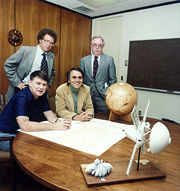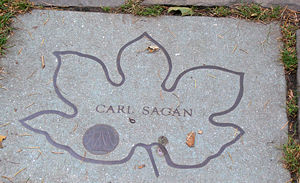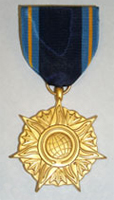Carl Sagan
2008/9 Schools Wikipedia Selection. Related subjects: Astronomers and physicists
| Carl Sagan | |
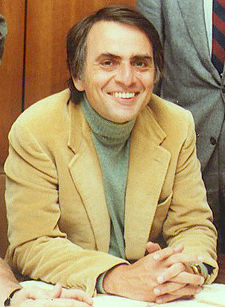 |
|
| Born | November 9, 1934 Brooklyn, New York, U.S. |
|---|---|
| Died | December 20, 1996 (aged 62) Seattle, Washington, U.S. |
| Residence | Ithaca, New York, U.S. |
| Nationality | American |
| Fields | Astronomy and planetary science |
| Institutions | Cornell University Harvard University |
| Alma mater | University of Chicago |
| Known for | Search for Extra-Terrestrial Intelligence (SETI) Cosmos: A Personal Voyage Voyager Golden Record Pioneer plaque Contact |
| Notable awards | Oersted Medal (1990) NASA Distinguished Public Service Medal (twice) Pulitzer Prize for General Non-Fiction (1978) NAS Public Welfare Medal (1994) |
Carl Edward Sagan ( November 9, 1934 – December 20, 1996) was an American astronomer, astrochemist and highly successful popularizer of astronomy, astrophysics and other natural sciences. He pioneered exobiology and promoted the Search for Extra-Terrestrial Intelligence (SETI).
He is world-famous for writing popular science books and for co-writing and presenting the award-winning 1980 television series Cosmos: A Personal Voyage, which has been seen by more than 600 million people in over 60 countries, making it the most widely watched PBS program in history. A book to accompany the program was also published. He also wrote the novel Contact, the basis for the 1997 Robert Zemeckis film of the same name starring Jodie Foster. During his lifetime, Sagan published more than 600 scientific papers and popular articles and was author, co-author, or editor of more than 20 books. In his works, he frequently advocated skeptical inquiry, secular humanism, and the scientific method.
Education and scientific career
Carl Sagan was born in Brooklyn, New York to a Jewish family. His father, Sam Sagan, was a garment worker; his mother, Rachel Molly Gruber, was a housewife. Carl was named in honour of Rachel's biological mother, Chaiya Clara, "the mother she never knew", in Sagan's words. Sagan graduated from Rahway High School in Rahway, New Jersey in 1951. He attended the University of Chicago, where he received a B.A. with general and special honours (1954), a B.S. (1955) and a M.S. (1956) in physics, before earning a Ph.D. degree (1960) in astronomy and astrophysics. During his time as an undergraduate, Sagan spent some time working in the laboratory of the geneticist H. J. Muller. From 1960 to 1962 he was a Miller Fellow at the University of California, Berkeley. From 1962 to 1968, he worked at the Smithsonian Astrophysical Observatory in Cambridge, Massachusetts.
Sagan lectured annually at Harvard University until 1968, when he moved to Cornell University. He became a full Professor at Cornell in 1971 and directed the Laboratory for Planetary Studies there. From 1972 to 1981 he was Associate Director of the Centre for Radio Physics and Space Research at Cornell.
Sagan was a leader in the U.S. space program since its inception. From the 1950s onward, he worked as an adviser to NASA. One of his many duties during his tenure at the space agency included briefing the Apollo astronauts before their flights to the Moon. Sagan contributed to most of the robotic spacecraft missions that explored the solar system, arranging experiments on many of the expeditions. He conceived the idea of adding an unalterable and universal message on spacecraft destined to leave the solar system that could be understood by any extraterrestrial intelligence that might find it. Sagan assembled the first physical message that was sent into space: a gold- anodized plaque, attached to the space probe Pioneer 10, launched in 1972. Pioneer 11, also carrying the plaque, was launched the following year. He continued to refine his designs throughout his lifetime; the most elaborate message he helped to develop and assemble was the Voyager Golden Record that was sent out with the Voyager space probes in 1977.
At Cornell, Sagan taught a course on critical thinking until his death in 1996 from a rare bone marrow disease. The course had only a limited number of seats. Although hundreds of students applied each year, only about 20 were chosen to attend each semester. The course was discontinued immediately after Sagan's death, but was later resumed by Professor Yervant Terzian in 2000.
Scientific achievements
Carl Sagan was central to the discovery of the high surface temperatures of the planet Venus. In the early 1960s, no one knew for certain the basic conditions of Venus' surface and Sagan listed the possibilities in a report later depicted for popularization in a Time-Life book, Planets; his own view was that the planet was dry and very hot, as opposed to the balmy paradise others had imagined. He had investigated radio emissions from Venus and concluded that there was a surface temperature of 500 °C (932 °F). As a visiting scientist to NASA's Jet Propulsion Laboratory, he contributed to the first Mariner missions to Venus, working on the design and management of the project. Mariner 2 confirmed his views on the conditions of Venus in 1962.
Sagan was among the first to hypothesize that Saturn's moon Titan and Jupiter's moon Europa may possess oceans, a subsurface ocean, as in the case of Europa, or lakes, thus making the hypothesized water ocean on Europa potentially habitable for life. Europa's subsurface ocean was later indirectly confirmed by the spacecraft Galileo. Sagan also helped solve the mystery of the reddish haze seen on Titan, revealing that it is composed of complex organic molecules constantly raining down to the moon's surface.
He furthered insights regarding the atmospheres of Venus and Jupiter as well as seasonal changes on Mars. Sagan established that the atmosphere of Venus is extremely hot and dense with crushing pressures. He also perceived global warming as a growing, man-made danger and likened it to the natural development of Venus into a hot, life-hostile planet through greenhouse gases. Sagan and his Cornell colleague Edwin Ernest Salpeter speculated about life in Jupiter's clouds, given the planet's dense atmospheric composition rich in organic molecules. He studied the observed colour variations on Mars’ surface, concluding that they were not seasonal or vegetation changes as most believed, but shifts in surface dust caused by windstorms.
Sagan is best known, however, for his research on the possibilities of extraterrestrial life, including experimental demonstration of the production of amino acids from basic chemicals by radiation.
He is also the 1994 recipient of the Public Welfare Medal, the highest award of the National Academy of Sciences for "distinguished contributions in the application of science to the public welfare."
Scientific advocacy
Sagan was a proponent of the search for extraterrestrial life. He urged the scientific community to listen with radio telescopes for signals from intelligent extraterrestrial lifeforms. So persuasive was he that by 1982, he was able to get a petition advocating SETI published in the journal Science, signed by 70 scientists, including seven Nobel Prize winners. This was a tremendous turnaround in the respectability of this controversial field. Sagan also helped Dr. Frank Drake write the Arecibo message, a radio message beamed into space from the Arecibo radio telescope on November 16, 1974, aimed at informing extraterrestrials about Earth.
Sagan was chief technology officer of the professional planetary research journal Icarus for twelve years. He co-founded the Planetary Society, the largest space-interest group in the world, with over 1,000,000 members in more than 149 countries, and was a member of the SETI Institute Board of Trustees. Sagan served as Chairman of the Division for Planetary Science of the American Astronomical Society, as President of the Planetology Section of the American Geophysical Union, and as Chairman of the Astronomy Section of the American Association for the Advancement of Science.
At the height of the Cold War, Sagan became involved in public awareness efforts for the effects of nuclear war when a mathematical climate model suggested that a substantial nuclear exchange could upset the delicate balance of life on Earth. He was the last of five authors — the "S" of the "TTAPS" report as the research paper came to be known. He eventually co-authored the scientific paper hypothesising a global nuclear winter following nuclear war. He also co-authored the book A Path Where No Man Thought: Nuclear Winter and the End of the Arms Race, a comprehensive examination of the phenomenon of nuclear winter.
Sagan erroneously warned in January 1991 that so much smoke from the Kuwaiti oil fires "might get so high as to disrupt agriculture in much of South Asia...." He acknowledged the error in The Demon-Haunted World: "as events transpired, it was pitch black at noon and temperatures dropped 4-6 C over the Persian Gulf, but not much smoke reached stratospheric altitudes and Asia was spared."
In his later years Sagan advocated the creation of an organized search for near Earth objects that would impact the Earth. ( Head, Tom (2006). Conversations With Carl Sagan. University Press of Mississippi, 86-87. ISBN 1578067367. ) When others suggested creating large nuclear bombs that could be used to alter the orbit of an NEO that was predicted to hit the Earth, Sagan proposed the Deflection Dilemma: If we create the ability to deflect an asteroid away from the Earth, then we also create the ability to deflect an asteroid towards the Earth - providing an evil power with a true doomsday bomb. ("David Morrison - Taking a Hit: Asteroid Impacts & Evolution". [ Valley Astronomy Lectures]. 2007- 10-03. ) (Sagan, Carl & Ostro, "Long-Range Consequences of Interplanetary Collisions", Issues in Science and Technology Vol X(Number 4))
Social concerns
Sagan believed that the Drake equation suggested that a large number of extraterrestrial civilizations would form, but that the lack of evidence of such civilizations pointed out by the Fermi paradox suggests technological civilizations tend to destroy themselves rather quickly. This stimulated his interest in identifying and publicizing ways that humanity could destroy itself, with the hope of avoiding such a cataclysm and eventually becoming a spacefaring species. Sagan's deep concern regarding the potential destruction of human civilization in a nuclear holocaust was conveyed in a memorable cinematic sequence in the final episode of Cosmos, called "Who Speaks for Earth?". Following his marriage to his third wife (novelist Ann Druyan) in June 1981, Sagan became more politically active — particularly in regard to the escalation of the nuclear arms race under President Ronald Reagan.
In March 1983, hoping to blunt the momentum of the nuclear freeze movement, Reagan announced the Strategic Defense Initiative — a multi-billion dollar project to develop a comprehensive defense against attack by nuclear missiles, which was quickly dubbed the "Star Wars" program. Sagan spoke out against the project, arguing that it was technically impossible to develop a system with the level of perfection required, and far more expensive to build than for an enemy to defeat through decoys and other means — and that its construction would seriously destabilize the nuclear balance between the United States and the Soviet Union, making further progress toward nuclear disarmament impossible.
When Soviet leader Mikhail Gorbachev declared a unilateral moratorium on the testing of nuclear weapons, which would begin on August 6, 1985 — the 40th anniversary of the atomic bombing of Hiroshima — the Reagan administration dismissed the dramatic move as nothing more than propaganda, and refused to follow suit. In response, American anti-nuclear and peace activists staged a series of protest actions at the Nevada Test Site, beginning on Easter Sunday of 1986 and continuing through 1987. Hundreds of people, including such notable figures as Daniel Ellsberg and Martin Sheen, engaged in acts of civil disobedience and were arrested. Carl Sagan, who had been arrested for participating in an anti-war protest during the Vietnam War, was himself arrested on two separate occasions as he climbed over a chain-link fence at the Test Site.
Popularization of science
Sagan's capability to convey his ideas allowed many people to better understand the cosmos — simultaneously emphasizing the value and worthiness of the human race, and the relative insignificance of the earth in comparison to the universe. He delivered the 1977/1978 Christmas Lectures for Young People at the Royal Institution. He hosted and, with Ann Druyan, co-wrote and co-produced the highly popular thirteen-part PBS television series Cosmos: A Personal Voyage modeled on Jacob Bronowski's The Ascent of Man.
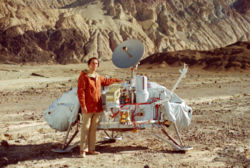
Cosmos covered a wide range of scientific subjects including the origin of life and a perspective of our place in the universe. The series was first broadcast by the Public Broadcasting Service in 1980, winning an Emmy and a Peabody Award. According to the NASA Office of Space Science, it has been since broadcast in more than 60 countries and seen by over 500 million people.
Sagan also wrote books to popularize science, such as Cosmos, which reflected and expanded upon some of the themes of A Personal Voyage, and became the best-selling science book ever published in English; The Dragons of Eden: Speculations on the Evolution of Human Intelligence, which won a Pulitzer Prize; and Broca's Brain: Reflections on the Romance of Science. Sagan also wrote the best-selling science fiction novel Contact, but did not live to see the book's 1997 motion picture adaptation, which starred Jodie Foster and won the 1998 Hugo Award.
From Cosmos and his frequent appearances on The Tonight Show, Sagan became associated with the catch phrase "billions and billions." Sagan never actually used the phrase in Cosmos series, however his frequent use of term billions, and distinctive delivery with emphasis on the “b”, made him a favorite target of performers and comedy routines of Johnny Carson, Gary Kroeger, Mike Myers, Bronson Pinchot, Harry Shearer and others. Sagan took this in good humor, and his final book was entitled Billions and Billions and opened with a tongue-in-cheek discussion of this catch phrase. The indefinite and fictitious number Sagan has arisen in popular culture to indicate a count greater than 4 billion.
He wrote a sequel to Cosmos, Pale Blue Dot: A Vision of the Human Future in Space, which was selected as a notable book of 1995 by The New York Times. He appeared on PBS' Charlie Rose program in January 1995. Sagan also wrote an introduction for the bestselling book by Stephen Hawking, A Brief History of Time.
Sagan caused mixed reactions among other professional scientists. On the one hand, there was general support for his popularization of science, his efforts to increase scientific understanding among the general public, and his positions in favour of scientific skepticism and against pseudoscience; most notably his debunking of the book Worlds in Collision by Immanuel Velikovsky. However, for as popular as this debunking was with science writers and the public, many of its arguments were flawed, as astronomer Robert Jastrow and Sagan's student, astronomer David Morrison, have explained. Concerning Sagan's great odds against a collision of 1 in 30,000 per 1000 years, using his statistical approach and Velikovsky's actual scenario, e.g., no grazing encounters, S. F. Kogan (Velikovsky's older daughter) showed the odds would be drastically reduced to 1 in 12 per 1000 years. Furthermore, Sagan's Appendix 3 on the cooling of Venus has nothing to do with cooling, but instead is a trivial identity that merely equates the heat radiated to Venus by the Sun in one hour at 6000K to the heat radiated from Venus in 3500 years at 79K. On the other hand, there was some unease that the public would misunderstand some of the personal positions and interests that Sagan took as being part of the scientific consensus.
Late in his life, Sagan's books elaborated on his skeptical, naturalistic view of the world. In The Demon-Haunted World: Science as a Candle in the Dark, he presented tools for testing arguments and detecting fallacious or fraudulent ones, essentially advocating wide use of critical thinking and the scientific method. The compilation, Billions and Billions: Thoughts on Life and Death at the Brink of the Millennium, published in 1997 after Sagan's death, contains essays written by Sagan, such as his views on abortion, and his widow Ann Druyan's account of his death as a skeptic, agnostic, and freethinker.
In 2006, Ann Druyan edited Sagan's 1985 Glasgow Gifford Lectures in Natural Theology into a new book, The Varieties of Scientific Experience: A Personal View of the Search for God, in which he elaborates on his views of divinity in the natural world.
Personal life and beliefs
In 1966, Sagan was asked to contribute an interview about the possibility of extraterrestrials to a proposed introduction to the film 2001: A Space Odyssey. Sagan responded by saying that he wanted editorial control and a percentage of the film's takings, which was rejected.
In 1994, Apple Computer began developing the Power Macintosh 7100. They chose the internal code name "Carl Sagan", the in-joke being that the mid-range PowerMac 7100 would make Apple "billions and billions." Though the project name was strictly internal and never used in public marketing, when Sagan learned of this internal usage he sued Apple Computer to force the use of a different project name. Other models released conjointly had code names such as " Cold fusion" and " Piltdown Man", and he was displeased at being associated with what he considered pseudoscience. (He was at the time writing a book debunking pseudoscience.) Though Sagan lost the suit, Apple engineers complied with his demands anyway, renaming the project "BHA" (for Butt-Head Astronomer). Sagan promptly sued Apple for libel over the new name, claiming that it subjected him to contempt and ridicule, but he lost this lawsuit as well. Still, the 7100 saw another name change: it was finally referred to internally as "LAW" (Lawyers Are Wimps).
Sagan wrote frequently about religion and the relationship between religion and science, expressing his skepticism about many conventional conceptualizations of God. Sagan once stated, for instance, that "The idea that God is an oversized white male with a flowing beard, who sits in the sky and tallies the fall of every sparrow is ludicrous. But if by 'God,' one means the set of physical laws that govern the universe, then clearly there is such a God. This God is emotionally unsatisfying... it does not make much sense to pray to the law of gravity." Sagan is also widely regarded as a freethinker or skeptic; one of his most famous quotations as seen in Cosmos, was "Extraordinary claims require extraordinary evidence." (This was actually based on a nearly identical earlier quote by fellow CSICOP founder Marcello Truzzi, "Extraordinary claims require extraordinary proof." The quote is also known, under different wording, as the principle of Laplace — attributed to Pierre-Simon Marquis de Laplace (1749-1827), a French mathematician and astronomer: "The weight of evidence for an extraordinary claim must be proportioned to its strangeness."
Sagan married three times: to biologist Lynn Margulis, mother of Dorion Sagan and Jeremy Sagan, in 1957; to artist Linda Salzman, mother of Nick Sagan, in 1968; and to author Ann Druyan, mother of Alexandra Rachel (Sasha) and Samuel Democritus (Sam), in 1981. His marriage to Druyan continued until his death in 1996.
Isaac Asimov described Sagan as one of only two people he ever met who was smarter than Asimov himself. The other was computer scientist and expert on artificial intelligence, Marvin Minsky.
Sagan was a user of marijuana. Under the pseudonym "Mr. X", he wrote an essay concerning cannabis smoking in the 1971 book Marihuana Reconsidered, written by Sagan's close friend Lester Grinspoon. In his essay, Sagan wrote how marijuana use had helped to inspire some of his works and enhance sensual and intellectual experiences. After Sagan's death, Grinspoon disclosed this to Sagan's biographer, Keay Davidson. The publishing of this biography, Carl Sagan: A Life, in 1999, brought much media attention to the issue of the use and legalization of marijuana.
Sagan and UFOs
Sagan had some interest in UFO reports from at least 1964, when he had several conversations on the subject with Jacques Vallee. Though quite skeptical of any extraordinary answer to the UFO question, Sagan thought scientists should study the phenomenon, at least because there was widespread public interest in UFO reports.
Stuart Appelle notes that Sagan "wrote frequently on what he perceived as the logical and empirical fallacies regarding UFOs and the abduction experience. Sagan rejected an extraterrestrial explanation for the phenomenon but felt there were both empirical and pedagogical benefits for examining UFO reports and that the subject was, therefore, a legitimate topic of study."
In 1966, Sagan was a member of the Ad Hoc Committee to Review Project Blue Book, the U.S. Air Force's UFO investigation project. The committee concluded Blue Book had been lacking as a scientific study, and recommended a university-based project to give the UFO phenomenon closer scientific scrutiny. The result was the Condon Committee (1966-1968), led by physicist Edward Condon, and in their final report, formally concluded that there was nothing anomalous about UFO reports.
Ron Westrum writes that "The high point of Sagan's treatment of the UFO question was the AAAS's symposium in 1969. A wide range of educated opinions on the subject were offered by participants, including not only proponents such as James McDonald and J. Allen Hynek but also skeptics like astronomers William Hartmann and Donald Menzel. The roster of speakers was balanced, and it is to Sagan's credit that this event was presented in spite of pressure from Edward Condon". With physicist Thornton Page, Sagan edited the lectures and discussions given at the symposium; these were published in 1972 as UFO's: A Scientific Debate. Jerome Clark writes that Sagan's perspective on UFO's irked Condon: "... though a skeptic, [Sagan] was too soft on UFOs for Condon's taste. In 1971, [Condon] considered blackballing Sagan from the prestigious Cosmos Club".
Some of Sagan's many books examine UFOs (as did one episode of Cosmos) and he recognized a religious undercurrent to the phenomenon. However, Westrum writes that "Sagan spent very little time researching UFOs ... he thought that little evidence existed to show that the UFO phenomenon represented alien spacecraft and that the motivation for interpreting UFO observations as spacecraft was emotional".
Sagan again revealed his views on interstellar travel in his 1980 Cosmos series. He rejected the idea that UFOs are visiting Earth, maintaining that the chances any alien spacecraft would visit the Earth are vanishingly small. In one of his last written works, Sagan again argued there was no evidence that aliens have actually visited the Earth, either in the past or present.
Death and legacy
After a long and difficult fight with myelodysplasia, which included three bone marrow transplants, Sagan died of pneumonia at the age of 62 at the Fred Hutchinson Cancer Research Centre in Seattle, Washington on December 20, 1996. Surviving him were his wife and five children. Sagan was a significant figure, and his supporters credit his importance to his popularization of the natural sciences, opposing both restraints on science and reactionary applications of science, defending democratic traditions, resisting nationalism, defending humanism, and arguing against geocentric and anthropocentric views.
After landing, the unmanned Mars Pathfinder spacecraft was renamed the Carl Sagan Memorial Station on July 5, 1997. Asteroid 2709 Sagan is also named in his honour.
The 1997 movie Contact, based on Sagan's novel of the same name and finished after his death, ends with the dedication "For Carl."
On November 9, 2001, on what would have been Sagan’s 67th birthday, the NASA Ames Research Centre dedicated the site for the Carl Sagan Centre for the Study of Life in the Cosmos. "Carl was an incredible visionary, and now his legacy can be preserved and advanced by a 21st century research and education laboratory committed to enhancing our understanding of life in the universe and furthering the cause of space exploration for all time", said NASA Administrator Daniel Goldin. Ann Druyan was at the centre as it opened its doors on October 22, 2006.
Sagan's son, Nick Sagan, wrote several episodes in the Star Trek franchise. In an episode of Star Trek: Enterprise entitled "Terra Prime", a quick shot is shown of the relic rover Sojourner, part of the Mars Pathfinder mission, placed by a historical marker at Carl Sagan Memorial Station on the Martian surface. The marker displays a quote from Sagan: "Whatever the reason you're on Mars, I'm glad you're there, and I wish I was with you."
Sagan has at least three awards named in his honour: the Carl Sagan Memorial Award presented jointly since 1997 by the American Astronautical Society (AAS) and the Planetary Society; the Carl Sagan Medal for Excellence in Public Communication in Planetary Science presented since 1998 by the American Astronomical Society's Division for Planetary Sciences (AAS/DPS) for outstanding communication by an active planetary scientist to the general public. Carl Sagan was one of the original organizing committee members of the DPS; and the Carl Sagan Award for Public Understanding of Science presented by Council of Scientific Society Presidents (CSSP). Sagan himself was the first recipient of the CSSP award in 1993. In 2006, the Carl Sagan Medal was awarded to astrobiologist and author David Grinspoon, the son of Sagan's friend Lester Grinspoon.
Sagan's student Steve Squyres led the team that landed the Spirit Rover and Opportunity Rover successfully on Mars in 2004.
On December 20, 2006, the tenth anniversary of Sagan's death, a blogger, Joel Schlosberg, organized a Carl Sagan "blog-a-thon" to commemorate Sagan's death, and the idea was supported by Nick Sagan. Many members of the blogging community participated.
Awards and honours
- Annual Award for Television Excellence - 1981 - Ohio State University - PBS series Cosmos
- Apollo Achievement Award - National Aeronautics and Space Administration
- NASA Distinguished Public Service Medal - National Aeronautics and Space Administration (twice)
- Emmy - Outstanding Individual Achievement - 1981 - PBS series Cosmos
- Emmy - Outstanding Informational Series - 1981 - PBS series Cosmos
- Exceptional Scientific Achievement Medal - National Aeronautics and Space Administration
- Helen Caldicott Leadership Award - Women's Action for Nuclear Disarmament
- Homer Award - 1997 - Contact
- Hugo Award - 1981 - Cosmos
- Humanist of the Year - 1981 - Awarded by the American Humanist Association
- In Praise of Reason Award - 1987 - Committee for the Scientific Investigation of Claims of the Paranormal
- Isaac Asimov Award - 1994 - Committee for the Scientific Investigation of Claims of the Paranormal
- John F. Kennedy Astronautics Award - American Astronautical Society
- John W. Campbell Memorial Award - 1974 - Cosmic Connection: An Extraterrestrial Perspective
- Joseph Priestley Award - "For distinguished contributions to the welfare of mankind"
- Klumpke-Roberts Award of the Astronomical Society of the Pacific - 1974
- Konstantin Tsiolkovsky Medal - Awarded by the Soviet Cosmonauts Federation
- Locus Award 1986 - Contact
- Lowell Thomas Award - Explorers Club - 75th Anniversary
- Masursky Award - American Astronomical Society
- Miller Research Fellowship - Miller Institute (1960-1962)
- Oersted Medal - 1990 - American Association of Physics Teachers
- Peabody Award - 1980 - PBS series Cosmos
- Prix Galbert - The international prize of Astronautics
- Public Welfare Medal - 1994 - National Academy of Sciences
- Pulitzer Prize for General Non-Fiction - 1978 - The Dragons of Eden
- SF Chronicle Award - 1998 - Contact
- Named the “ 99th Greatest American” on the June 5, 2005 Greatest American show on the Discovery Channel.
